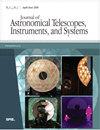Software architecture and development approach for the ASTRI Mini-Array project at the Teide Observatory
IF 1.7
3区 工程技术
Q2 ENGINEERING, AEROSPACE
Journal of Astronomical Telescopes Instruments and Systems
Pub Date : 2024-01-01
DOI:10.1117/1.jatis.10.1.017001
引用次数: 0
Abstract
The Astrophysics with Italian Replicating Technology Mirrors (ASTRI) Mini-Array is an international collaboration led by the Italian National Institute for Astrophysics (INAF) and devoted to imaging atmospheric Cherenkov light for very-high γ-ray astrophysics, detection of cosmic-rays, and stellar Hambury-Brown intensity interferometry. The project is deploying an array of nine dual-mirror aplanatic imaging atmospheric Cherenkov telescopes of 4-m class at the Teide Observatory on Tenerife in the Canary Islands. Based on SiPM sensors, the focal plane camera covers an unprecedented field of view of 10.5 deg in diameter. The array is most sensitive to γ-ray radiation above 1 up to 200 TeV, with an angular resolution of 3 arcmin, better than the current particle arrays, such as LHAASO and HAWC. We describe the overall software architecture of the ASTRI Mini-Array and the software engineering approach for its development. The software covers the entire life cycle of the Mini-Array, from scheduling to remote operations, data acquisition, and processing until data dissemination. The on-site control software allows remote array operations from different locations, including automated reactions to critical conditions. All data are collected every night, and the array trigger is managed post facto. The high-speed networking connection between the observatory site and the Data Center in Rome allows for ready data availability for stereoscopic event reconstruction, data processing, and almost real-time science products generation.特德天文台应科院小型阵列项目的软件架构和开发方法
意大利反射镜复制技术天体物理学小型阵列(ASTRI)是由意大利国家天体物理学研究所(INAF)领导的一个国际合作项目,致力于大气切伦科夫光成像,用于甚高γ射线天体物理学、宇宙射线探测和恒星汉布里-布朗强度干涉测量。该项目正在加那利群岛特内里费岛的泰德天文台部署一个由九台 4 米级双镜平面成像大气切伦科夫望远镜组成的阵列。焦平面照相机以 SiPM 传感器为基础,覆盖直径为 10.5 度的前所未有的视场。该阵列对 1 至 200 TeV 以上的 γ 射线辐射最为敏感,角度分辨率为 3 弧分,优于目前的粒子阵列,如 LHAASO 和 HAWC。我们介绍了应科院迷你阵列的整体软件架构及其软件工程开发方法。该软件涵盖了微型阵列的整个生命周期,从调度到远程操作、数据采集和处理,直至数据发布。现场控制软件允许从不同地点进行远程阵列操作,包括对关键条件做出自动反应。所有数据每晚收集,阵列触发由事后管理。观测站和罗马数据中心之间的高速网络连接使数据可随时用于立体事件重建、数据处理和几乎实时的科学产品生成。
本文章由计算机程序翻译,如有差异,请以英文原文为准。
求助全文
约1分钟内获得全文
求助全文
来源期刊

Journal of Astronomical Telescopes Instruments and Systems
Engineering-Mechanical Engineering
CiteScore
4.40
自引率
13.00%
发文量
119
期刊介绍:
The Journal of Astronomical Telescopes, Instruments, and Systems publishes peer-reviewed papers reporting on original research in the development, testing, and application of telescopes, instrumentation, techniques, and systems for ground- and space-based astronomy.
 求助内容:
求助内容: 应助结果提醒方式:
应助结果提醒方式:


